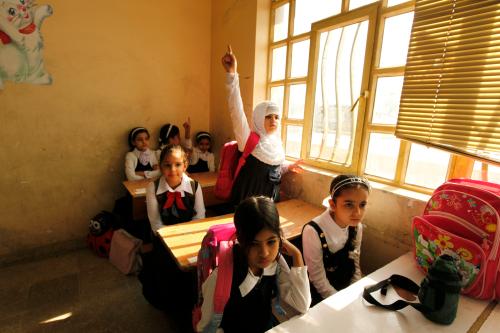The case is clear: Investments in young children have enormous payoffs for society. This global movement in the early education sector has already influenced one of the targets for U.N. Sustainable Development Goal 4, to “ensure that all girls and boys have access to quality early childhood development, care and preprimary education so that they are ready for primary education.”
The question is not whether we should invest in young children, but when and how. The answer has often been increased interest in high-quality preschool education—a mandate that has universal appeal—with preschool investments reshaping the education landscape in Ghana, Sweden, and many others. In the U.S. alone, cities and states (e.g., Boston, Tulsa, New Jersey, and Tennessee) have rolled out extensive “universal” preschool initiatives such that today, 75 percent of the nation’s 4-year-olds, and 65 percent of those 4-year-olds living in poverty, have access to at least some preschool education. The emphasis has turned to whether the deliverables can move beyond access to child care to access to high-quality child care—a subject of a recent report by Brookings and the Duke University Center for Child and Family Policy.
Amidst these initiatives, new research on early brain development suggests that preschool, while important, may not be enough. Laura Betancourt and Hallam Hurt from the Children’s Hospital of Philadelphia found that one-year-olds growing up in poverty are already lagging behind their middle-income peers on tests of language and cognitive ability. The researchers previously noted evidence of differences in brain size as early as 5 weeks old—differences that are unlikely to be explained by exposure to language and environmental stimulation. In their study of 44 infants, newborns from low-income families had less grey matter (i.e., the part of the brain where information is processed) than their middle-income peers. This suggests that differences in prenatal environments may be at play.
Although this is one of the first studies to demonstrate very early signs of brain differences, there are other reports of brain differences between low- and middle or high-income children, with particularly depressed growth in the hippocampus (memory), amygdala (emotion understanding), and frontal lobes (attention, language and self-control).
Babies’ brains grow rapidly in the womb but malnutrition and maternal stress are likely to hinder that growth. Thus, it should come as no surprise that the myriad of stressors faced by pregnant mothers living under the poverty line (e.g., food insecurity, housing insecurity, domestic violence) likely have a strong impact on their baby’s developing brain. For example, mothers who are exposed to infections and stress are more likely to experience premature birth and have babies with growth issues. Furthermore, in animal studies, stress during pregnancy impedes neural development in the fetus and has a major impact on structures underlying self-control, attention, and memory. Beyond stress, toxins, nutrition, and physical health, other aspects of maternal health also affect brain development.
Though these data are shocking, there is a silver lining. Research demonstrates that we can alter the trajectories for brain growth! There are successful interventions that positively affect cognitive development very early, and these differences in cognition and behavior are likely to reflect changes in brain development. Programs that provide stimulation early in development to infants at high risk for developmental delays, because of poverty or low birth weight, have produced improvements in cognitive and motor skills. Several home visiting programs, such as the Nurse Family Partnership in Memphis, find similar results. There are also promising suggestions of brain changes. The Newborn Individualized Developmental Care and Assessment Program offers an intervention in the neonatal intensive care unit (NICU). This study with premature infants targeted changes to the infants’ environment along with increases in human interaction and skin-to-skin contact. In turn, these changes resulted in increases in coherence between brain regions and brain connectivity in neonates. These results indicate that neural growth can be malleable to our interventions.
Even more encouraging, brain imaging of children who are removed from adverse situations—such as those reared in institutions in Romania—demonstrates that when children are put in an enriched environment, they catch up in some aspects of brain development, while their peers who stay behind do not. This change is also reflected in their brain functioning. As in many animal studies, these results demonstrate the impact of enriched environments and improved caregiving on brain growth.
Brain development can be enhanced with timely and targeted interventions
Children born into poverty, on average, may have differences in their brain development. This reality is likely due to both pre- and post-natal environmental differences, and gene environment interactions, but not solely a product of differences in their genes. It is therefore subject to change.
Perhaps it is time to augment the drive towards preschool with a similar focus on expectant mothers and babies 0 to 3 years old. Preschool education might even be too late to mitigate gaps in development that are already emerging by age 3. A few programs that have taken up this charge, including the Nurse Family Partnership, Minding the Baby, SMART beginnings, and the ABC Project, and they are all demonstrating promising results in child behavior and cognition.
However, as of yet, none of these projects has asked the key question about whether we can foster better brain growth even before the baby is born—to give every child a head start, or at least an even chance. The extant data suggest that it might be beneficial for children born into poverty.
Preschool might narrow the gap between low-income children and their more advantaged peers. And while it is critically important, it cannot close the gap. If baby brains are already showing signs of poverty from birth, our policies and programs must address this fact. Brain matter matters. Smaller brains portend more cognitive risk. But there is something we can do about it.









Commentary
Brain matter matters: Should we intervene well before preschool?
August 21, 2017